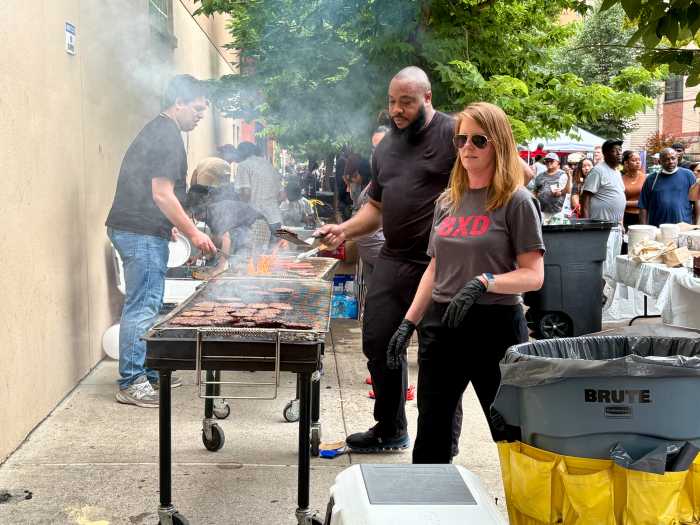By WILL McKINLEY
Film preservationist Ron Hutchinson talks about talkies at Film Forum
In the early years of the 20th Century, New York City was the Vaudeville capital of America, with a pantheon of popular — and often peculiar — performers plying their trade live on stage. A few stars of that era found fame in other mediums, but most were swept away by the technological tidal wave known as “talking pictures.” End of story. Or, maybe not.
On February 19, Film Forum cracks open the time tunnel with “Vitaphone Varieties of 2009,” a program of restored, 1920s short subjects featuring famous and not-so-famous personalities from Vaudeville’s dying days. Produced by Warner Bros. using the Vitaphone sound-on-disc process — film projected in sync with a record played on a turntable — these shorts are some of the earliest surviving talkies, but the majority had been separated from their soundtracks and rendered mute.
Cue Ron Hutchinson. The 56-year-old East Orange, New Jersey native co-founded the Vitaphone Project in 1991 with the mission of reuniting sound with picture, and restoring history for a new generation. Hutchinson will introduce the Film Forum program, part of the movie house’s month-long “Breadlines and Champagne” series of classics from the first — and hopefully last — Great Depression.
WILL McKINLEY: How many Vitaphone shorts were produced?
RON HUTCHINSON: Almost 2,000 between 1926 and 1932. Most were made in Brooklyn.
WM: Where in Brooklyn?
RH: The building is still there, on East 14th Street and Avenue M.
WM: Is it still an active studio?
RH: It’s now a Hebrew girls’ school. After Warner Bros. left in 1939 it was used by NBC for many years. That’s where “The Cosby Show” was shot. On the other side of the street, “As the World Turns” is still shot there everyday. It’s one of the oldest, continually used studios in the world.
WM: What was the content of the shorts?
RH: The intent was to save theaters money so they wouldn’t have to hire live performers, and to bring the biggest stars of opera, Vaudeville and comedy to the smallest theaters. The idea was to present, without a lot of cinematic touches, verbatim recreations of their stage performance.
WM: And they bow at the end, right?
RH: Yes. That was part of the simulation of a live performance.
WM: How many programs has the Vitaphone Project done at Film Forum?
RH: This will be the tenth. They’ve always had lines forming about two hours before the show, and they’re normally standing room only. People fly in from other states.
WM: So get your tickets early. Who comes to these shows?
RH: You would think just hardcore, older film buffs. And there are certainly some of those, but it’s refreshing to see entire families, with children. There are film students who come. There have also been relatives of the performers who are on the screen. It’s a really diverse mix.
WM: There’s one short in this program that features New York City native Irving Larheim, who is better known as…
RH: Bert Lahr, the Cowardly Lion in “The Wizard of Oz.” At the time of the short in 1928, he was in Vaudeville with his wife Mercedes. His son John Lahr is a well-known writer and film critic for The New Yorker.
WM: There will also be an Edgar Bergen film as well, right?
RH: Yes, we’re showing a short with Edgar Bergen and his ventriloquist dummy Charlie McCarthy. Long before he was a household name via radio, he made a series of shorts at Vitaphone.
RH: I’m amazed at how racy the Bergen-McCarthy stuff is.
Oh yes. And he maintained that, obviously reined in somewhat, after the [Motion Picture Production] Code. There was a famous appearance on radio in 1937 with Mae West and it was so double entendre that Mae West was banned from radio permanently.
WM: There’s also an Al Jolson film on the program, correct?
RH: Two, actually. There’s a short called “A Plantation Act” made in 1926, a full year before “The Jazz Singer.” They found the film in the ‘90s at the Library of Congress and we were able to locate the only known disc – cracked in five places, but finally repaired. Also, as a companion to my program, Film Forum is showing the 1931 Jolson feature “Hallelujah, I’m a Bum.”
WM: Audience members will need to bring their historical perspective to “A Plantation Act.”
RH: Yes. Jolson performs in black face, which was a very entrenched tradition at the time. It was not a slur, and he does not caricature black people in his performance. At the time it was a fully accepted mechanism, mainly to emphasize to the back rows of a theater the performer’s features – the mouth, hands, and eyes. Obviously today it’s not acceptable.
WM: I don’t think people realize just how popular Al Jolson really was.
RH: His absolutely appropriate title was, “The World’s Greatest Entertainer.” This was at a time before radio and talking pictures, so his fame came from performing in major musical programs that toured the country. He was bigger than the biggest star you could think of today.
WM: Jolson was short and balding. He looked like he worked at a bakery. And he was the Brad Pitt of the 1920s?
RH: It was his electrifying personality and immediate connection with the audience that superseded all of that. It’s said that “A Plantation Act” best captures what the real Jolson was like if you saw him in person: pure, undistilled energy. He helped to put talkies on the map with this short.
WM: My favorite act on the bill is Shaw & Lee. That is some of the hippest comedy I have seen in a long time.
RH: They are bizarre. People love them more than any of the others we’ve done. I’ve heard from their grandsons. They’ve attended the screenings and seen how beloved they are now. Who knew who those guys were, even three years ago? Nobody.
WM: Assuming you’re not related to the performers, why should the average moviegoer care about the Vitaphone shorts?
RH: These films are a time capsule of a totally lost part of show business history. They’re not just boring pieces of history. People laugh and react today pretty much the same way they did back in the 1920s.
WM: Are any of the shorts available on DVD?
RH: Yes. There are 24 shorts on the DVD release of “The Jazz Singer” from Warner Home Video. It was the biggest selling black & white DVD set last year. Warner Bros. has always been in the forefront of restoring their own holdings.
WM: Of all the studios they’re the ones that get it the best, right?
Yes. They get it and they share it. They share it through DVDs and Turner Classic Movies, which they own. A lot of the studios could care less.
RH: How many Vitaphone films have been restored so far?
We’ve uncovered 3,500 previously unknown soundtrack discs in private hands and we’ve worked with those entities on restoring almost 90 shorts and 12 features that were made using the disc system.
WM: Who finances these restorations?
RH: Private individuals who just love film or Vaudeville. Some have been done by prominent people like David Packard of Hewlett-Packard and Hugh Hefner.
WM: Which one did Hef pay for? Was it a stripper act?
RH: Hugh Hefner funded several all girl band shorts as well as the restoration of Bing Crosby’s long-lost first film “Two Plus Fours.” He loves anything with Crosby, jazz or women.
WM: So someone can call you up and say, ‘I’d like to finance the restoration of a particular film.’
RH: Or they could ask, “What’s available?” That happens about a dozen times a year.
WM: How much does it cost?
RH: It’s $4,500 and the money goes right to UCLA. Our goal is just to develop the leads.
WM: So for less than $5,000 you could be the person responsible for saving a piece of American popular cultural history.
RH: Yup. And it’s tax deductible and you get onscreen credit and a copy.
WM: And you make a lifelong friend in Ron Hutchinson.
RH: There you go. How’s that for a deal?
For more information visit vitaphoneproject.com.

































